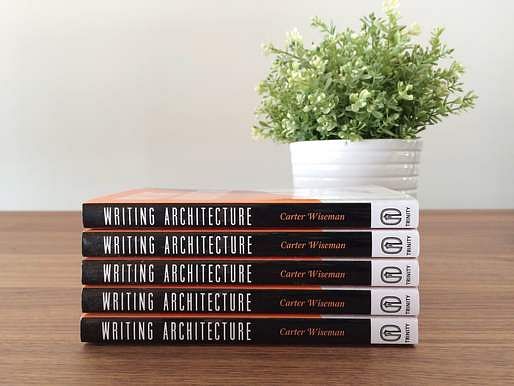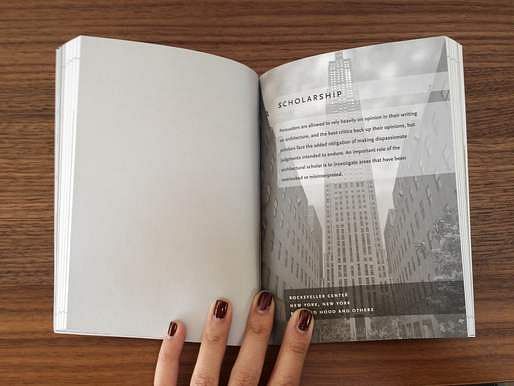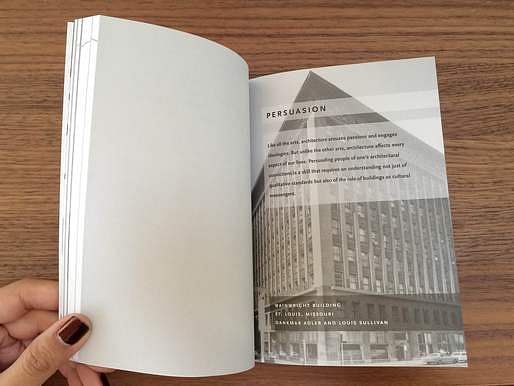
As we know, having the ability to communicate ideas behind an architectural design is crucial in the architectural profession. But perhaps what's more important is knowing how to write about architecture in a way that is accessible and appealing to non-architectural folks as well, considering that the built environment plays a significant part in shaping people's everyday experiences.
In relation to this, Yale University lecturer and practitioner Carter Wiseman discusses the process, techniques, and the value of architecture writing in his book, "Writing Architecture: A Practical Guide to Clear Communication About the Built Environment" recently published by Trinity University Press.
If you're eager to get your hands on a copy, now is your chance. Archinect is giving away five copies of the book to our readers!
TO ENTER THE GIVEAWAY: In the comment section below, tell us your biggest struggle in writing about architecture. Giveaway ends on October 17, 2014. Five winners will be selected. Good luck!
Read on to learn more about the book.

"As Wiseman states in his introduction, 'architecture is the most comprehensive and complex of the arts' because of the huge role it plays in our lives. He adds, 'Anyone who produces, promotes, or teaches architecture must be able to depend on accurate analysis and lucid explication to encourage design that may make the world a better place.'"

"In the book, Wiseman addresses several principles that he believes writers on architecture should possess, including the basic structure of a piece of writing, common standards for what differentiates a good building from a bad one, passion and conviction, and an appreciation for the emotion and imagination literature bestows upon us.
The author believes that many in the field lack the necessary clarity of thinking and expression to write successfully about architecture. To address this problem, he illustrates the techniques of architecture writing with excerpts from writers across genres and historical periods to provide a unique and authoritative perspective."



"Writing Architecture draws from Wiseman’s many years of writing, editing, and helping architects express themselves in a way that will keep their clients happy. Free of professional and academic jargon, Writing Architecture is a useful reference for practicing architects, students, and to any reader interested in the built environment."
TO ENTER THE GIVEAWAY: In the comment section below, tell us your biggest struggle in writing about architecture. Giveaway ends on October 17, 2014. Five winners will be selected. Good luck!
27 Comments
My bigast strugal is spelang.
Trying to express my ideas clearly.
My biggest struggle in writing about architecture is finding words that convey the impact of a spatial experience.
translating space/form into words!
I have a hard time verifying my sources.
"Writing about music is like dancing about architecture."
- Elvis Costello
- or possibly Frank Zappa
- it might have been Gore Vidal
- and was just as likely Martin Mull
- but Angelina Jolie misquoted it in a movie, so my guess is that it was first originated by
- Brad Pitt
...
Focusing on the essential parts is hard for me - less is more! ;)
I work in the field of architectural preservation. My greatest struggle with writing about architecture is communicating design ideals from a different historic era. Architecture embodies social/economic, owner/user, artistic expression and material priorities. How much context is needed to understand what that building meant and how it felt for the society who first experienced it?
My biggest struggle is to make my ideas clear to people without a technical background or knowledge of some of the jargon used in the area. Even though the clients grab the gist of the writing, it still lacks in compellence. The problem is further aggravated because my line of work deals with transit projects, so it requires not only architectural but also transport engineering basic knowledge. It can be very challenging to persuade government agencies to adopt certain elements in the project because of it.
My biggest struggle is to not use the baroquesh cassiest words of others!
I am an Architect from India, pursuing higher education in the UK. I have been introduced to architectural research and writing lately. What has intrigued me is this metaphysical choice the literature makes with me. It is the learning within me aroused by the itching curiosity to unravel further onto something that arouses writing. In essence, it is the choice of the stone to subject itself to becoming a sculpture. It invites the chisel. The biggest challenge in writing is this discovery. It is the uncouth beginning, the hardest part of it all. That spark which quite brings forests down, initiating a fury or taming the wild.
I always struggle trying to express relationships in architecture which are simultaneous and spatial using written language which is linear and organized around actions-results.
It's also tough writing a short statement about a complex situation, but that's not unique to architecture. Doing it well is time-consuming.
my biggest struggle is not telling Thayer to go fuck himself.
My biggest struggle (and challenge) when writing about architecture is the same as when talking to clients, how best to express the feelings a certain building or space will convey. That's why I'm always curious to hear lay people's method of communicating their feelings about architecture, to learn their language and use it as the basis for making my ideas accessible and appealing (hopefully).
My biggest struggle is figuring out where to start and what to focus on. Sifting through the vague feelings and initial reactions to find what is actually worth writing about.
Keeping it short. No one wants to read more than 140 characters these days.
making the text longer than 140 characters and getting people to read it.
I guess my biggest struggle is always to not repeat myself. I think it is really important to be able to express every idea in a neat and clear way, using the appropiate vocabulary, so my idea is straightly communicated.
I am Spanish, so this book would really help me to improve my English architectural texts. Fingers crossed!
Thanks for the initiative, it will be a huge success!
Paula
Architecture and the profession is a constantly moving target. Materials, technology, style, and fashion are constantly evolving and as such the greatest challenge to writing is time.
Having written design review board analyses of some 20+ 6-story, wood-frame, stucco-clad apartment buildings, I've run out of creative ways to describe this typology. Yet the buildings keep coming, and the bureaucratic staff reports still need to be written...
I am writing a series of books for struggling readers in the 9-11 year old age group and I would love to have this book to help me incorporate more visual and spatial imagery into the writing.
The hardest part i've had is communicating a visual experience to people that are unable to depart from their untrained visual habits.
Working on my capstone project right now for my masters, I think the hardest thing about writing about architecture is to find the balance between writing too much and writing too little, between too technical and too layman-esque, and between too vibrantly and full of fluff and too flat and short.
Actually, I think the hardest part is just doing it... or even starting to write. I am only a masters student writing for my committee members who have been working in the field for more than I have been alive and have more than 100 publications under their belts. How am I suppose to compare to that?
The greatest struggle would be to present my ideas in the less complicated way without having to lower the quality of my writing.
Using a single language that is understood by colleagues and clients.
In writing about architecture, we must first know who we are trying to convince, and why. I believe that much of what we might want to say, often through blind enthusiasm for our art, can fall upon deaf ears unless it can connect with analogies and contexts that the reader can associate with. So to use another (potentially tangential) analogy, you are unlikely to woo a prospective romantic date with an overly poetic philosophical appraisal of ones own beauty and talent; on the whole, that will simply be self evident or not, and let's face it, it is not our place to determine that! But ingratiating ourself comes through saying those often simple things that will lead to the other person falling in love with the subject, and enjoying their own appraisal (potentially with the lights off!) To bring this back down to earth with a bump, if we want to be heard as well as read, we need to create that love for, and interest in architecture, in the reader first, and be ready to say less, by instead encouraging people to put their boots on the ground and to move through the spaces we want to appraise. We should stand on fewer podiums, and instead enthuse readers of any audience, to get out their and see the buildings, spaces, exhibitions we are so excited about in the first place. That is what they are there for, and it's why we build them in the first place, right?
With that said, I'm off to enjoy the magnificent yet confined neo-etheral juxtaposed modernist forms that are my office kitchen, and drink tea with the self-satisfaction that my words have touched the hearts and minds of the Archinect community (or at least the ones handing out the books!)
Thanks for the comments everyone! We'll announce the winners soon.
COMMENTING IS NOW CLOSED.
Block this user
Are you sure you want to block this user and hide all related comments throughout the site?
Archinect
This is your first comment on Archinect. Your comment will be visible once approved.